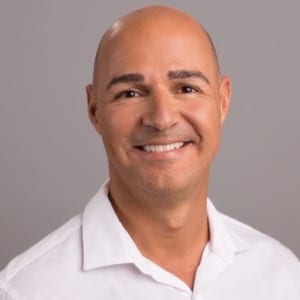Celebrate National Scoliosis Awareness Month This June
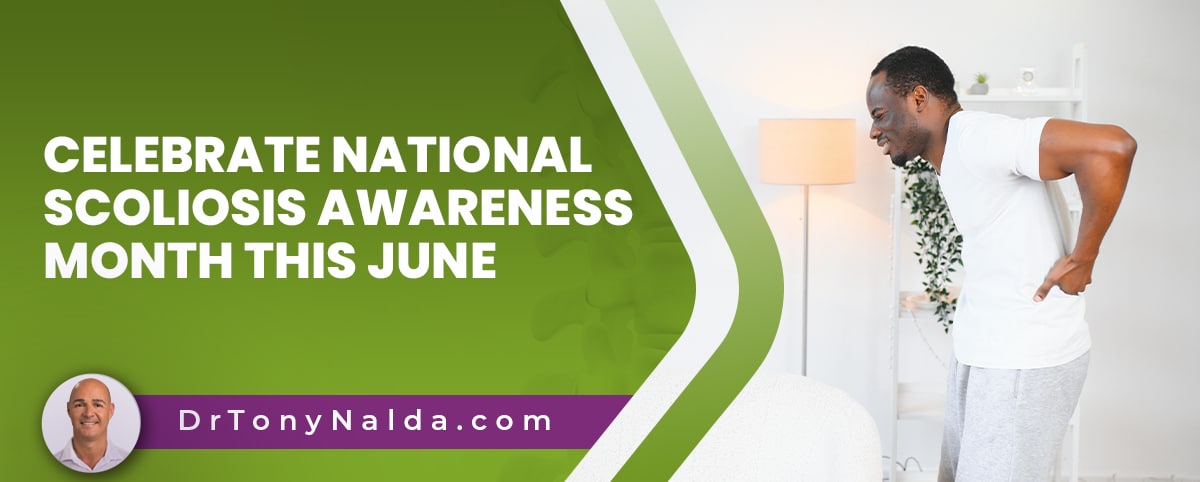
Spreading awareness about scoliosis involves understanding the condition's progressive nature and why it's so beneficial to start treatment as early as possible. Scoliosis awareness is also about the different types of treatment options.
National scoliosis awareness month is this June. As a progressive condition triggered by growth, how a diagnosis of scoliosis is responded to is key, and with early detection and intervention, there are fewer limits to what non-surgical scoliosis treatment can achieve.
With close to seven million people living with scoliosis in the United States alone, raising awareness means understanding a highly-prevalent spinal disorder.
Table of Contents
What is Scoliosis?
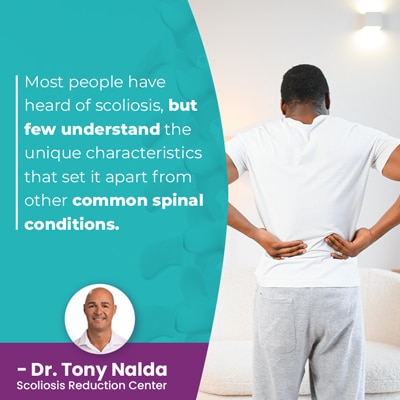 Most people have heard of scoliosis, but few understand the unique characteristics that set it apart from other common spinal conditions.
Most people have heard of scoliosis, but few understand the unique characteristics that set it apart from other common spinal conditions.
Scoliosis is a structural spinal condition that causes the development of an unnatural sideways-bending and rotating spinal curvature; there has to be rotation to be considered a true scoliosis.
Scoliosis is only diagnosed if the curve size is a minimum of 10 degrees, and this is determined by a patient's Cobb angle measurement.
A patient's Cobb angle measurement also indicates condition severity which can range from mild scoliosis to moderate scoliosis, severe and very severe scoliosis.
An abnormal curvature of the spine needs to be taken seriously because it can affect the spine, its surrounding muscles and nerves, and the entire body.
Every case of scoliosis is unique, but let's talk about some common symptoms to look out for.
Scoliosis Symptoms in Children
Scoliosis affects all ages but is most often diagnosed in children, and the most common type overall is adolescent idiopathic scoliosis diagnosed between the ages of 10 and reaching skeletal maturity.
Scoliosis introduces a lot of uneven forces to the body, and postural changes are the most common condition effects in children.
The following symptoms of scoliosis involve posture deviation:
- The head appearing uncentered over the torso
- Uneven shoulders
- Uneven shoulder blades
- Uneven hips
- An uneven waist line
- The development of a rib cage arch
- Arms and legs hanging at different lengths
In many cases of childhood scoliosis, the earliest signs are uneven shoulders and hips, and as scoliosis progresses, changes to gait, balance, and coordination are also common.
Although scoliosis is more frequently diagnosed in children, it also affects adults, and the actual rate of scoliosis increases among the aging population.
Common Symptoms of Adult Scoliosis
Symptoms of adult scoliosis include postural changes and a prominent lean to one side, but the main symptom of adult scoliosis is pain.
Once skeletal maturity has been reached and there is no more growth occurring, the condition becomes compressive; compression is uneven pressure, and this is the main cause of condition-related pain.
Adult scoliosis pain can involve the muscles, the back, and pain that radiates into the extremities due to nerve compression.
So for adults, pain is the most common symptom that brings them in to see me for assessment and leads to a diagnosis.
The main types to affect adults are idiopathic scoliosis and degenerative scoliosis.
Awareness of Different Types of Scoliosis
I want to spread awareness about the importance of early detection and the fact that there are also different types of scoliosis.
The main type overall is idiopathic scoliosis, meaning not clearly associated with a single-known cause, and this type accounts for approximately 80 percent of known cases, and the remaining 20 percent are associated with known causes: neuromuscular scoliosis, degenerative scoliosis, and congenital scoliosis.
Neuromuscular scoliosis is caused by the presence of a larger neuromuscular condition like spina bifida, cerebral palsy, and muscular dystrophy.
Degenerative scoliosis affects older scoliosis patients and is caused by natural age-related spinal degeneration.
Congenital scoliosis is caused by a malformed spine that develops in utero.
So not only are there wide-ranging severity levels of scoliosis, there are also different types with unique characteristics and treatment needs.
And now let's address the benefits associated with early detection as this is the main motivation behind spreading scoliosis awareness.
The Benefits of Early Detection
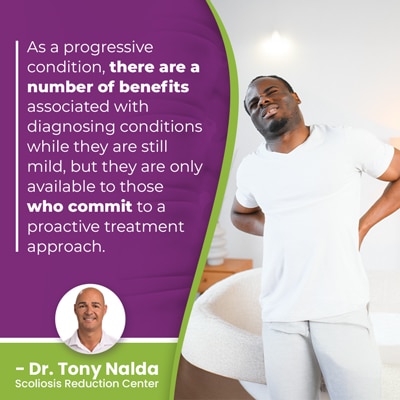 As a progressive condition, there are a number of benefits associated with diagnosing conditions while they are still mild, but they are only available to those who commit to a proactive treatment approach.
As a progressive condition, there are a number of benefits associated with diagnosing conditions while they are still mild, but they are only available to those who commit to a proactive treatment approach.
Proactive treatment options are started immediately following a diagnosis in the hopes of preventing progression, increasing condition effects, and the need for more invasive forms of surgical treatment.
The benefits of early detection mean starting treatment when conditions are most likely to respond well.
As scoliosis progresses, the size and rotation of the unnatural spinal curve is increasing, and this makes the spine more rigid and less responsive; in fact, in many cases where significant progression has already occurred, efforts have to be made prior to the regular course of treatment to establish a baseline level of spinal flexibility.
So starting treatment early in a condition's progressive line means it may be easier to correct; the spine will be more flexible and the condition's effects won't be so established.
With progressive conditions, it's generally more effective to proactively work towards preventing increasing effects than it is to attempt to reverse changes once they've been established for some time.
Here at the Scoliosis Reduction Center®, a proactive conservative treatment approach is offered to patients, and our results speak for themselves.
So now that we've covered the benefits of being diagnosed and starting treatment early, let's talk about scoliosis screening.
Scoliosis Screening
It's not always easy to diagnose scoliosis while mild, particularly in children for whom the condition isn't commonly painful.
The effects of mild scoliosis are also mild and can be too subtle for many to notice, and this is where awareness comes in: awareness of the condition's subtle signs and risk factors that make screening even more important.
Scoliosis screening involves a physical examination and an Adams forward bend test, and if the examination finds condition indicators such as trunk asymmetries, further testing in the form of a scoliosis X-ray is ordered to truly see what's happening in and around the spine.
With scoliosis screening conducted by a medical professional, the condition's often subtle early signs are less likely to be missed, and this can lead to an earlier diagnosis and the opportunity to start treatment earlier.
Risk Factors
Scoliosis risk factors include gender, age, and a family history. Females are more likely than males to develop scoliosis that's severe, and this is thought to be related to the earlier start of puberty in females; scoliosis progression is triggered by growth.
Patients who have not yet reached skeletal maturity are more at risk for rapid progression, so childhood scoliosis should always be taken seriously, especially as scoliosis is the leading spinal condition among school-aged children.
Adolescents are the most at risk for rapid-phase progression due to the rapid and unpredictable growth spurts of puberty, so there are a number of benefits associated with starting treatment prior to the first significant pubescent growth spurt.
Scoliosis isn't a genetic condition, but it is considered familial because if a family member has already been diagnosed with scoliosis, this increases the likelihood that another member will be.
Scoliosis isn't considered genetic because a single gene, or genetic mutation, that accounts for the development of idiopathic scoliosis has yet to be found, yet it does seem to run in families.
Families share a lot more than just their genes, and as idiopathic scoliosis is thought to be multifactorial, this makes sense. Families also can share a common diet, lifestyle, responses to stress, body type, socioeconomic factors, geography, etc.
Conclusion
National Scoliosis Awareness Month highlights the prevalence of scoliosis and the importance of early detection and intervention.
June also encourages patients to ensure they are educated on the different treatment options available because how a diagnosis is responded to can shape the spine's long-term health and function.
The two main treatment approaches include traditional surgical treatment and modern conservative non-surgical treatment.
Surgical treatment is invasive and involves a type of spinal fusion, and conservative treatment offers a less invasive treatment alternative with impressive results.
A spine that's fused is fused forever and is going to be weaker and more vulnerable to injury, and can also be more rigid with a reduced range of motion.
Conservative treatment works towards restoring as much of the spine's healthy curves as possible while preserving as much of the spine's natural strength and function as possible.
While there are never treatment guarantees, there is a direct link between early detection, intervention, and treatment success.
So this June, consider wearing a green ribbon to show support and help spread awareness of how prevalent scoliosis is, among children in particular, and how treatable the condition can be with early detection.
Dr. Tony Nalda
DOCTOR OF CHIROPRACTIC
After receiving an undergraduate degree in psychology and his Doctorate of Chiropractic from Life University, Dr. Nalda settled in Celebration, Florida and proceeded to build one of Central Florida’s most successful chiropractic clinics.
His experience with patients suffering from scoliosis, and the confusion and frustration they faced, led him to seek a specialty in scoliosis care. In 2006 he completed his Intensive Care Certification from CLEAR Institute, a leading scoliosis educational and certification center.
About Dr. Tony Nalda
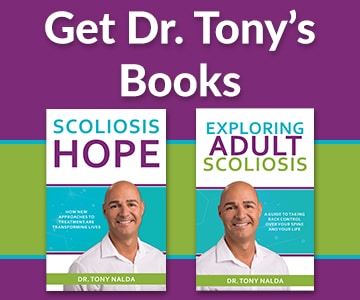 Ready to explore scoliosis treatment? Contact Us Now
Ready to explore scoliosis treatment? Contact Us Now
